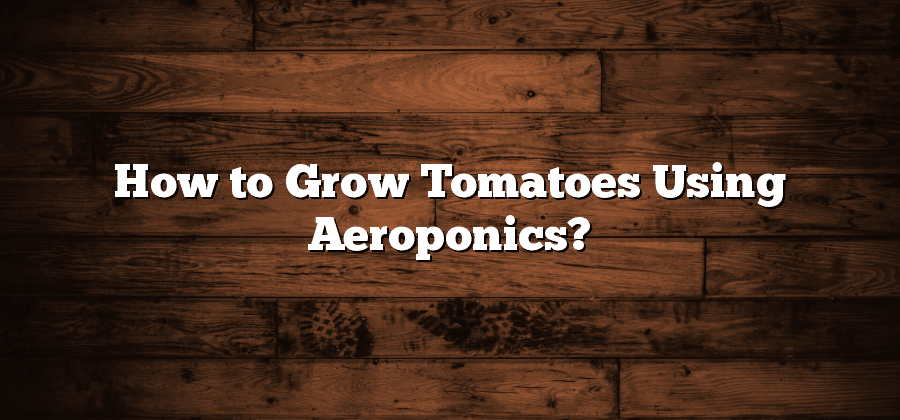Selecting the Right Tomato Varieties for Aeroponics
When it comes to selecting the right tomato varieties for aeroponics, there are a few factors to consider. Firstly, it’s important to choose varieties that are well-suited to hydroponic growing methods. These varieties are typically known for their vigor, disease resistance, and high yields. Look for varieties that have been specifically bred for hydroponic or greenhouse cultivation, as they are more likely to thrive in an aeroponics system.
In addition, consider the characteristics that you desire in your tomatoes. Are you looking for small cherry tomatoes, or larger beefsteak varieties? Do you prefer a certain color, such as red, orange, or yellow? Determining your preferences in terms of taste, texture, and appearance will help you narrow down your options. Keep in mind that some tomato varieties may require additional support, such as trellising or staking, to ensure optimum growth and prevent sprawling. By carefully selecting the right tomato varieties for your aeroponics system, you are setting yourself up for success in your tomato cultivation endeavors.
Preparing the Aeroponics System for Tomato Cultivation
One of the crucial steps in successfully cultivating tomatoes in an aeroponics system is the preparation of the system itself. Before starting the tomato cultivation process, it is important to ensure that the aeroponics system is set up correctly and ready to provide the optimum growing conditions for the plants.
Firstly, it is essential to thoroughly clean and sanitize the aeroponics system. Any residual debris or pathogens can pose a risk to the tomato plants and hinder their growth. Using a mild disinfectant solution, carefully clean all the components of the system, including the reservoir, tubes, and nozzles. Rinse them thoroughly to remove any remaining residue and allow them to air dry completely. This step helps in minimizing the chances of unwanted contaminants entering the system and ensures a healthy environment for the tomatoes.
Providing Adequate Lighting for Tomato Growth
Proper lighting is essential for optimal tomato growth in an aeroponics system. As tomatoes are photophilic plants, they heavily rely on light for photosynthesis and subsequent fruit development. When selecting lighting for your aeroponics setup, it is important to consider the intensity, spectrum, and duration.
Firstly, the intensity of light is crucial to ensure vigorous growth and fruit production. Tomatoes require high-intensity lighting to sufficiently penetrate the thick foliage and reach the lower leaves. The recommended light intensity for tomato cultivation in aeroponics is around 700-1000 micromoles per square meter per second (µmol/m²/s). This can be achieved by using high-quality LED grow lights or high-pressure sodium (HPS) lamps, which emit light in the wavelengths that tomatoes need for optimal growth.
Secondly, the spectrum of light plays a significant role in tomato growth. Plants primarily utilize blue and red light for photosynthesis, with blue light promoting vegetative growth and red light stimulating flowering and fruiting. Therefore, a balanced spectrum of blue and red light is ideal for tomato cultivation. LED grow lights with customizable spectral outputs are highly recommended, as they allow growers to adjust the light spectrum according to the plant’s growth stage and requirements.
Lastly, the duration of light exposure is key to maintaining healthy tomato plants. As a general guideline, tomatoes in their vegetative stage require around 16-18 hours of light per day, whereas during the flowering and fruiting stages, the duration can be reduced to 12-14 hours. Using a timer system is beneficial as it ensures consistent and appropriate light exposure for the plants.
Ensuring adequate lighting for tomato growth in aeroponics is vital for achieving high yields and healthy plants. By carefully selecting the light intensity, spectrum, and duration, growers can provide an optimal environment for their tomato plants to thrive and produce abundant, tasty fruits.
Maintaining the Ideal Temperature and Humidity Levels
To ensure successful cultivation of tomatoes in an aeroponics system, it is crucial to maintain the ideal temperature and humidity levels. Tomatoes thrive in warm and humid conditions, which mimic their natural growth environment. It is recommended to aim for a temperature range of 70-85°F (21-29°C) during the day and 60-70°F (15-21°C) at night. Deviating from these optimal temperatures can negatively impact the growth and development of the tomato plants.
In addition to temperature, proper humidity levels are equally important for the health and productivity of tomatoes. Ideally, the relative humidity should be maintained between 60-70% to prevent excessive moisture loss through transpiration. This can be achieved by using a humidifier or misting system, especially during the hot and dry periods. However, it is crucial to avoid excessive humidity, as it can increase the risks of fungal diseases and adversely affect the overall growth and quality of the tomato plants. Achieving the right balance of temperature and humidity will enhance the overall performance of tomatoes in an aeroponics system.
Nurturing Tomato Seedlings in Aeroponics
Nurturing tomato seedlings in an aeroponics system is crucial for their healthy growth and successful transplantation. Adequate care at this stage ensures that the seedlings develop strong roots and robust stems, enabling them to withstand the challenges of the aeroponic environment.
One essential aspect of nurturing tomato seedlings is providing them with the right nutrient solution. In an aeroponics system, the nutrient solution is delivered directly to the roots through a fine mist, allowing for optimal nutrient uptake. It is important to monitor the nutrient solution regularly and adjust its composition as the seedlings mature. Additionally, maintaining the pH level of the nutrient solution within the recommended range is vital for preventing nutrient deficiencies or toxicities that can hinder the seedlings’ development. Efficient aeration of the nutrient solution also aids in promoting healthy root growth and nutrient absorption.






